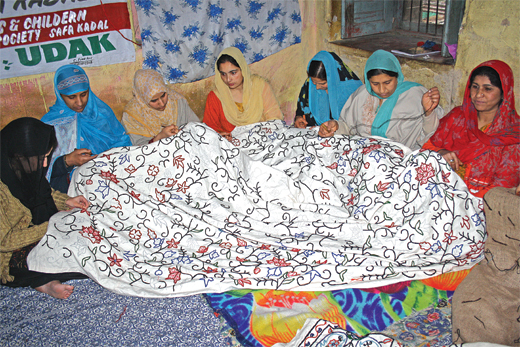M Shariq Farooqi
 The handicraft industry in Jammu and Kashmir occupies an important place in its economy besides being a significant contributor to its foreign exchange earnings. The state’s handicrafts enjoy a prominent position on the world map of handicrafts export.
The handicraft industry in Jammu and Kashmir occupies an important place in its economy besides being a significant contributor to its foreign exchange earnings. The state’s handicrafts enjoy a prominent position on the world map of handicrafts export.
The handicrafts sector provides employment to over 3.30 lac artisans and the overall production has registered a high of Rs 663 crore in the year ending March 2000. The handicrafts sector has helped Kashmir sustain economically during the decade of political disruption when the entire socio-economic order got shattered. This is evident from the annual carpet production that exhibited a steep increase from Rs 293 crore in 1996 to Rs 557 crore in 2000.
In a state where handicrafts have already proved their worth and where there are vast areas so remote as to make it impossible for major modern industries to be set up, vigorous initiatives for developing handicrafts can be specially rewarding. Capital investment in handicrafts is low and employment potential high. However, like anywhere else, in Kashmir the handicrafts industry is threatened by mass products that seem to be far less expensive, trendy and full of variety. At the same time, industrial goods also present an intense competition to handmade products, with look-alikes and imitations claiming to be original and flooding the domestic and international markets.
Statistics indicate that authentic Pashmina, hand crafted in Kashmir, is likely to perish soon, given that 70% of its production is now machine based with extensive adulteration and fakes, even within its home ground. Established international retail brands are themselves confused and advising caution to consumers while buying Pashmina without credible means of differentiating the original from imitations. China is presently the largest producer supplying around 7,500 tons of Cashmere goods every year. However, with demand being far greater than the supply, cheaper Chinese blends and replicas have eroded the brand value and quality associated with the original Pashmina. Cases of rampant mislabeling of goods from China and India have been confiscated in the Japanese, German, US and UK retail markets. Thus the present market share of about 0.3% of the Cashmere/ Pashmina from Kashmir and Ladakh, could be significantly enlarged if corrective measures are taken to ensure its authenticity and quality as well as introducing formal recognition of the Kashmir Pashmina brand.

The basis of creation of widespread high-value markets for Kashmiri handicrafts including Pashmina lies in the building of a tangible “Kashmir” brand image that is easily identifiable by the consumer. Consumers respond to that image through loyalty and willingness to pay more.
The first has already been accomplished through the registration of six traditional crafts of Kashmir, under the Geographical Indications of Goods (Registration & protection) Act 1999 (GI Act). These include Kashmir Pashmina, Kashmir Sozni, Kani Shawl, Kashmir Papier-mâché, Kashmir Walnut Wood Carving and Khatamband. The registration is acknowledgement of the fact that a given craft is unique and is produced in a particular area and no manufacturer other than those registered may claim to produce or sell the same by the specified name.
A testing and quality certification facility for Pashmina is under construction at Craft Development Institute, Srinagar, so that due share of Kashmir Pashmina may be reclaimed in the global market through its standardization and hallmarking. This requirement has led to the exploration of interesting systems such as the Radio Frequency Identification (RFID) and Nanotechnology based secure fusion authentication labels that enable immediate and automatic identification and tracking of an item through the whole supply chain. In applied terms it means that each tested product shall carry a permanently fixed tag coded with information about the manufacturing source as well as item specifications.
The tag could be read by a code reader anywhere in the world and send the information to a centralized station meant for validating the same. Several cases of infringement and inappropriate use of the registered GIs have already been legally addressed. These included two cases of legal action against Padam Shree Weaving & Mfg. Mills Pvt. Ltd. and Almas Delux Pashmina. Both the Mumbai companies were found using the name “Pashmina” as part of their respective trademarks. Complaints were filed by CDI, to the Trademarks Registry against the use of “Pashmina” by these companies. Almas Delux Pashmina has agreed to delete “Pashmina” from their Trademark. Many more such instances are under observance and are being identified both at national and international level to be addressed with necessary legal action. Success stories regarding implementation of already registered GIs in the country include Darjeeling Tea, Pochampalli Sarees or Mysore Silk.
(M Shariq Farooqi is Director Craft Development Institute, Srinagar)













